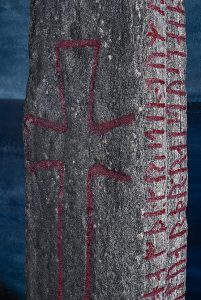The Kuli Stone was originally located on the island of Kuloy, between Edøy and Smøla in the skerries outside Kristiansund in Nordmøre (map). The stone is 1.90 m high and is a thin four-sided rune stone with a cross engraved on one of the broad sides. When the stone was brought to the NTNU University Museum in 1913, it was placed in the museum’s garden. It stood there for 43 years until Professor Aslak Liestøl happened to walk past the stone in the low afternoon sunlight one day in 1956. Suddenly, he caught sight of the long rows of runes covering the entire narrow side of the stone.

80 runes
The two rows of runes are written in the younger runic alphabet, in use about 800-1400 AD. The two rows are separated by a deeply etched line, and each line starts with a little cross before the runes. The top part of the stone is missing, so the original text was probably longer than the preserved section. The inscription has been interpreted several times, most recently in 1998 after examination using microcartographic technology (laser scanning).
The interpretation based on the scan explains that inscription on the stone should probably be read as:
Þórir ok Hallvarðr reistu stein þansi ept*****
Twelf vintr hafði kristendómr um rétt i Nóregi
Tore and Halvard raised this stone after *****…
Twelve winters had Christianity done good (things) in Norway…

Propaganda for Christianity
The most recent interpretation of the inscription on the Kuli Stone explains an important detail that was not known previously. The phrase “um rétt” means “ensuring law and order”. For twelve winters, Christianity had thus either improved things or secured law and order in Norway. Although the new interpretation is still the subject of academic discussion, there is evidence that the inscription should be read as propaganda for the new religion that had come to the country. According to professor and runologist Jan Ragnar Hagland at NTNU, this makes the stone even more interesting historically, because the inscription is clearly proselytizing for the new ideology, which even then was controversial in this country.

Norway’s documentary heritage
Norway’s documentary heritage is the Norwegian part of UNESCO’s Memory of the World Register. In 2012, the Kuli Stone was included in Norway’s documentary heritage. The justification states that the Kuli stone provides a source for understanding early nation building, the role of Christianity in the process and the social structure and routes of a bygone age.
The Kuli Stone is an irreplaceable cultural heritage monument and document, which shows that Norway had been gathered into one kingdom and had a new religion, forming the basis for the development of the Norwegian nation and its culture. The significance of the Kuli Stone for Norway can be compared with the significance of the Danish Jelling Stone for Denmark. This is older than the Kuli Stone, and mentions the name of Norway as early as the second half of the 900s. But the name on the Kuli Stone is the first on Norwegian soil, along with a date estimate that makes this the closest we can get to a baptismal certificate for the country of Norway.
References:
https://www.ntnu.no/museum/kulisteinen
Pettersen, Kristian: Kuløy – sentralt i går, utkant i dag [Kuløy – central yesterday, on the outskirts today]. SPOR 1986:2
Universitetsavisa No. 18:1998 : https://www.ntnu.no/universitetsavisa/1898/kulistein.html
The Norwegian Council for Cultural Affairs: Memory of the world – Norway’s documentary heritage
http://www.kulturradet.no/sok?cx=001373341755208255918%3Ajyt42psl3sk&ie=UTF-8&q=kulisteinen

